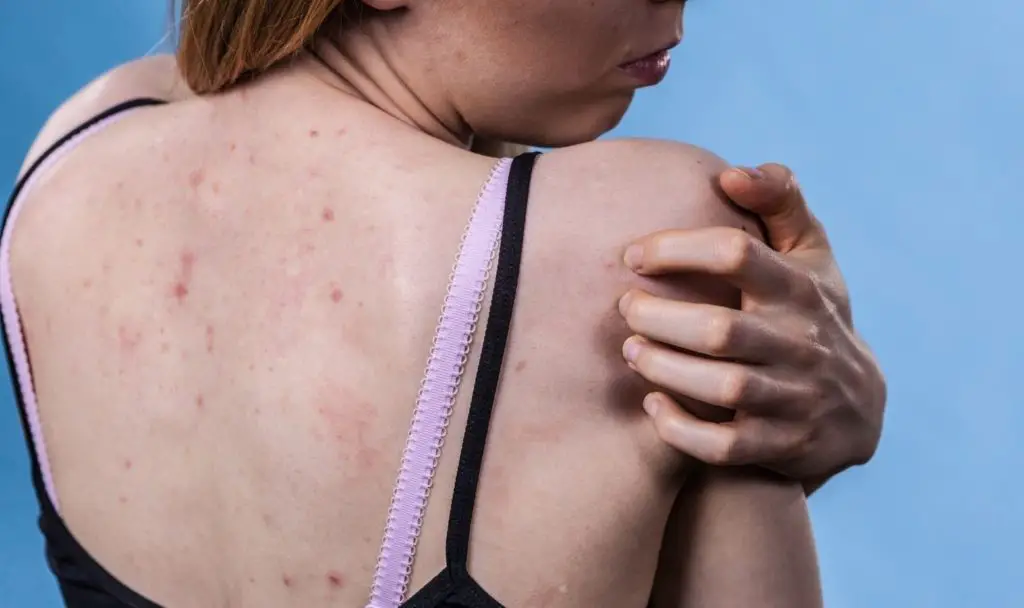Whether you’re about to go away on holiday or simply getting ready for a date, there’s nothing more frustrating than having a skin breakout. Whilst there’s no shame in having pimples around your body – after all it happens to most people – it’s only fair that we all want to look and feel our best.
Body acne, like all acne, is best treated with a holistic approach, as well as a little bit of trial and error.

Moreover, body acne can often indicate what’s going on inside your body. Just as face mapping is said to reflect the condition of the rest of the body, body mapping can be used as an equally viable method of understanding why we’re breaking out and what can be done to prevent it.
This guide will take an in-depth look at the potential meanings behind acne breakouts around the body, starting from the neck, working down.
Neck
Acne around the neck area can often be related to hormonal imbalance. If you’re experiencing a particularly bad breakout here, it may be best to get your hormones checked. Reducing your intake of refined sugar is a worthwhile change to make, as this can often trigger hormonal imbalance.
Neck acne can also be caused by irritation from tight-fitted shirts or hair products. So, try wearing a couple of looser shirts for a few days, and make sure your hair products are suitable for your skin type.
Chest
A breakout in the chest region could be a sign of an imbalance in your liver, an allergic reaction, or an imbalance in the gut. Just like with neck acne, it may also be caused by tight clothing or soap that irritates the skin.
To limit breakouts in this region, avoid eating too much spicy food and try to drink room temperature beverages – nothing too cold.
Shoulders
While hormonal fluctuations can contribute to acne around the shoulders, the most likely cause is clogged pores. The best way to treat this type of acne is to regularly shower, especially after exercise. Excessive sweating or straps can cause friction against the skin, subsequently making the breakouts worse.
Also, try to exfoliate your skin with a gentle shower sponge and a non-toxic, non-irritating body wash. This will help to soothe the sensitive area.
Arms
If you’re suffering from acne breakouts on your arms, the most common explanation is that you’re experiencing a vitamin deficiency. This is usually vitamin A, D or K2.
Breakouts in this area are often confused with allergic rashes. In particular, the little bumps caused by keratosis pilaris, a condition related to a build-up of protein keratin, which can block a hair follicle.
Acne on the arms can also be caused by overactive oil glands.
Stomach
Acne on the stomach is far less common than the previous areas of the body. However, it can still be caused by a number of factors. Most notably, tight clothes or fabrics that irritate the skin. If this is the case, it’s worth considering switching to loose-fitting clothing that’s made with gentler, more breathable materials.
Tight clothing and excessive sweating can also lead to other pimple-like irritations such as ingrown hairs, which are just as unpleasant.
The V
Breakouts in this area are usually related to ingrown hairs or a wider health issue. The V part of the body is particularly susceptible to high levels of moisture and warmth.
Another reason for acne breakouts in this region is the possibility of having an STD. If you’re unsure about whether this is the case, get it checked out by a doctor to be safe.
Thighs
A variety of factors such as allergies, sensitive skin, and ingrown hairs can all be to blame for acne on your thighs. One of the most common causes of acne in this area is Folliculitis, an inflammation of the body’s hair follicles.
To help limit breakouts, try using a gentle exfoliating wash, and switch to wearing loose-fitting pants for a few days.
Butt
There’s widespread belief that breakouts on the butt are linked to issues with digestion. If this is the case, it’s a good idea to get in the habit of popping a probiotic before bed every night.
Other likely causes of acne on the butt include clogged hair follicles, tight clothing, and an excessively-sedentary lifestyle.
Back
Whether it’s hormonal fluctuations or just a sweaty, active lifestyle, acne on the back is fairly common. If you’re active and regularly sweat during your workouts, make sure to shower straight after and change into clean clothes.
Pores on the back are larger, and more likely to clog than the pores on the face. Therefore, avoid anything that may irritate them such as perfumes and dyes.
If, after making these changes, you’re still not seeing improvement, many health experts recommend cutting back on fried foods and making sure you get plenty of sleep.
Frequently Asked Questions
Can sunlight help cure acne?
While sunlight may be beneficial for your skin in the short-term, it can actually do more harm than good for acne.
The sun’s ultraviolet (UV) rays kill acne-causing bacteria which is why your pimples may clear up temporarily. Moreover, pimples and blemishes tend to appear less obvious when your skin is tanned.
However, excessive sun exposure can result in your pimples ending up as dark scars. This is because the sun’s UV can increase inflammation and redness, as well as creating new breakouts.
Do blackheads and whiteheads count as acne?
Yes, blackheads and whiteheads are considered inflammatory types of acne. They are the mildest forms of acne and don’t tend to cause any considerable swelling.
Blackheads typically occur when the pores on your skin are clogged by a combination of dead skin cells and sebum – an oily, waxy substance that’s produced by the body’s sebaceous glands. Despite the pores being clogged, the top of them remain open. This is why the black color is seen on the surface.
Whiteheads also occur when your pores get clogged by sebum and dead skin cells, but unlike with blackheads, the top of the pores close up. This creates a small white-colored bump on the skin’s surface.
You can easily treat both with over-the-counter remedies. The most effective is salicylic acid, which naturally exfoliates the skin, removing the dead skin cells that lead to blackheads and whiteheads. Look for this ingredient when buying cleansers, moisturizers and toners.
Can a dermatologist help with acne?
If your acne is getting severe and you’re becoming increasingly worried about it, you should consult a dermatologist. They’ll often be able to prescribe antibiotics that can kill bacteria and reduce some of the inflammation. Hormone therapy may also work for some people, which includes a small dose of estrogen and progesterone.
